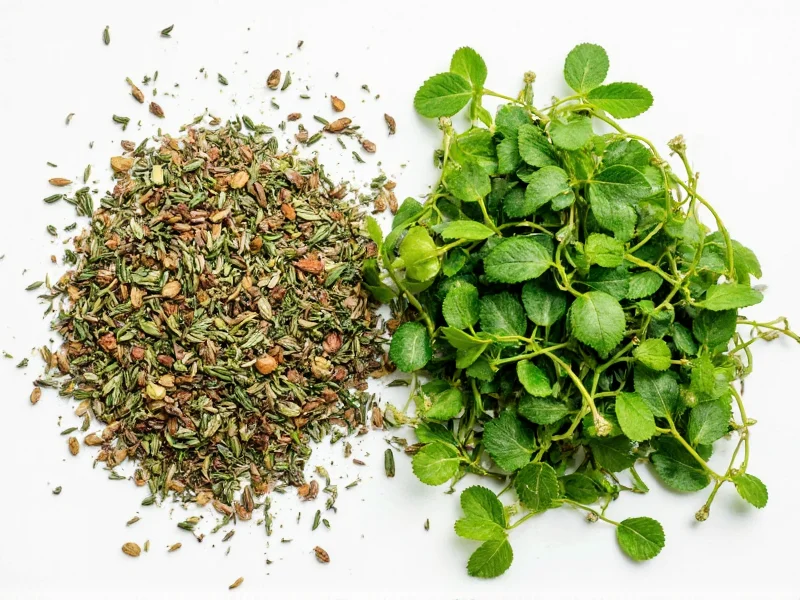Understanding herb conversions is essential for consistent cooking results. When herbs dry, they lose moisture but retain concentrated flavors, making dried versions more potent than their fresh counterparts. This fundamental culinary principle affects everything from simple weeknight dinners to elaborate holiday feasts.
Why the 1:3 Ratio Works for Most Herbs
Drying removes approximately 90-95% of an herb's water content, intensifying its flavor compounds. This concentration means you need less dried herb to achieve similar flavor impact as fresh. The 1:3 ratio serves as a reliable starting point for most common culinary herbs, though several factors can influence the ideal substitution:
- Herb variety - Some herbs concentrate more than others during drying
- Storage conditions - Properly stored dried herbs maintain potency longer
- Recipe timing - When you add herbs during cooking affects required amounts
- Personal taste preferences - Adjust to your specific palate
Detailed Herb Conversion Reference
| Common Herb | Fresh Measurement | Dried Measurement | Special Considerations |
|---|---|---|---|
| Basil | 1 tablespoon | 1 teaspoon | Fragile when dried; add late in cooking |
| Oregano | 1 tablespoon | 1 teaspoon | Dried oregano often more flavorful than fresh |
| Thyme | 1 tablespoon | 1 teaspoon | Sturdy when dried; works well in long-cooking dishes |
| Rosemary | 1 tablespoon | 1.5 teaspoons | Very potent dried; use slightly more than standard ratio |
| Dill | 1 tablespoon | 0.5 teaspoon | Loses flavor quickly when dried; use less |
| Parsley | 2 tablespoons | 1 teaspoon | Milder flavor when dried; requires different ratio |
| Cilantro | 2 tablespoons | 0.5 teaspoon | Flavor profile changes significantly when dried |
Practical Substitution Guidelines
When substituting dried herbs for fresh in your recipes, follow these professional kitchen practices:
For Long-Simmering Dishes
Add dried herbs early in the cooking process for soups, stews, and braises. The extended cooking time allows dried herbs to rehydrate and release their full flavor. Start with the standard 1:3 ratio, then adjust during the final seasoning phase.
For Quick-Cooking Recipes
In dishes with short cooking times like sautés or omelets, add dried herbs about 10-15 minutes before completion. This prevents bitter flavors from developing while allowing sufficient time for flavor release.
For Finishing Touches
When using herbs as a garnish or in cold applications like salad dressings, fresh herbs generally provide superior flavor and texture. If substituting dried herbs in these applications, use only half the standard ratio and consider toasting them lightly first to enhance flavor.
Factors Affecting Herb Potency
Several variables influence how much dried herb you should use:
Storage Duration
Dried herbs gradually lose potency over time. Herbs stored properly in airtight containers away from light maintain peak flavor for 6-12 months. After one year, you may need to increase the amount by 25-50% to achieve the same flavor intensity.
Grinding Method
Crushing dried herbs between your fingers before adding them to dishes releases more essential oils than simply sprinkling them in. This technique can reduce the required amount by up to 20% while enhancing flavor distribution.
Recipe Acidity
Acidic ingredients like tomatoes or vinegar can intensify herb flavors. When cooking with acidic components, start with 75% of the recommended dried herb amount, then adjust after the dish has simmered.
When Substitution Doesn't Work Well
Certain herbs don't translate well from fresh to dried forms. Delicate herbs like chives, tarragon, and cilantro undergo significant flavor changes during drying. For these varieties, consider these alternatives:
- Freeze fresh herbs in oil for longer storage with minimal flavor loss
- Use herb-infused vinegars or salts as substitutes
- Grow small indoor herb gardens for year-round fresh supply
- Seek specialty dried herb products specifically formulated for cooking
Maximizing Dried Herb Flavor
Professional chefs employ these techniques to get the most from dried herbs:
- Bloom in oil - Heat dried herbs in a small amount of oil for 30-60 seconds before adding other ingredients
- Toast lightly - Briefly heat dried herbs in a dry pan to awaken essential oils
- Rehydrate - Soak dried herbs in warm broth or water for 5-10 minutes before use
- Layer flavors - Add half the dried herbs at the beginning and half near the end of cooking
Storing Dried Herbs Properly
To maintain optimal potency of your dried herbs:
- Store in airtight containers away from light and heat
- Keep away from stove, sink, or other moisture sources
- Label containers with purchase or drying date
- Test potency by rubbing and smelling before use
- Replace herbs that no longer release strong aroma when crushed











 浙公网安备
33010002000092号
浙公网安备
33010002000092号 浙B2-20120091-4
浙B2-20120091-4